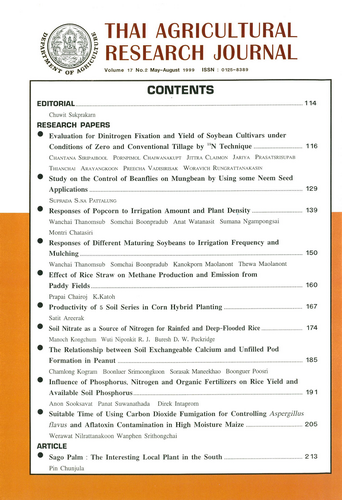Responses of Different Maturing Soybeans to Irrigation Frequency and Mulching
DOI:
https://doi.org/10.14456/thaidoa-agres.1999.15Keywords:
soybean, irrgation frequency, mulching, yieldAbstract
The response of different maturing soybean cultivars to irrigation frequency and mulching was examined in two consecutive growing seasons (1993/94 and 1994/95) at Chai Nat Field Crop Research Centre (CN.FCRC) and in the 1993/94 growing season at Phitsanuloke Field Crop Experiment Station (PL.FCES). A split-split plot design with 3 replicates was used. Irrigation frequencies, 42 mm of irrigation applied after every 60 and 120 mm cumulative pan evaporation and once at 50% flowering (I60,I120 and IF respectively) were deployed as main plots. Sub-plots were mulching with 2 tons of rice straw and without mulching, wheres 3 different maturing soybean cultivars were used as sub-sub plots. There were no interactions between soybean cultivars, irrigation frequency and mulching in each experiment. At CN. FCRC, average seed yields wee reduced by 27-30 and 43-45% with reducing irrigation frequencies from I60 to I120 and IF, respectively Similarly, at PL. FCES seed yield decreased by 12 and 37% with decreasing irrgation frequencies from I60 to I120 and IF, respectively. An average seed yield of mulching was 10-12 and 18% greater than that of no mulching for the experiments conducted at CN. FCRC and PL> FCES respectively. A greater yield of the higher irrigation frequencies resulted from increasing pods/plant and seed size, whereas pods/plant was the main yield component responsible for yield difference between mulching and without mulching. At CN.FCRC, the intermediate cultivar, Chiang Mai 60 gave 3-5% seed yield greater than the earliest cultivar, Nakhon Sawan 1 and the latest cultivar, SJ. 5 which produced no significant differences in seed yield. At PL>FCES, Nakhon Sawan 1 and Chiang Mai 60 showed no statistically significant differences in seed yield but the both cultivars attained 16-22% seed yield greater than SJ> 5. Nakhon Sawan 1 produced the greatest seed size but Chiang Mai 60 and SJ. 5 compensated by having higher number of pods per plant.
Downloads
Published
How to Cite
Issue
Section
License

This work is licensed under a Creative Commons Attribution-NonCommercial-NoDerivatives 4.0 International License.
Thai Agricultural Research Journal



